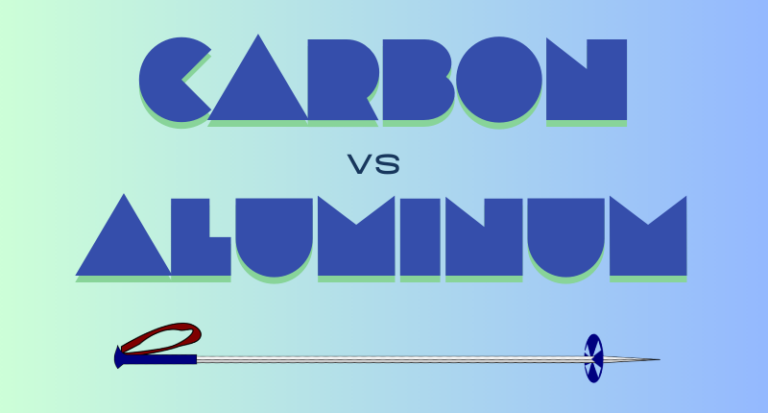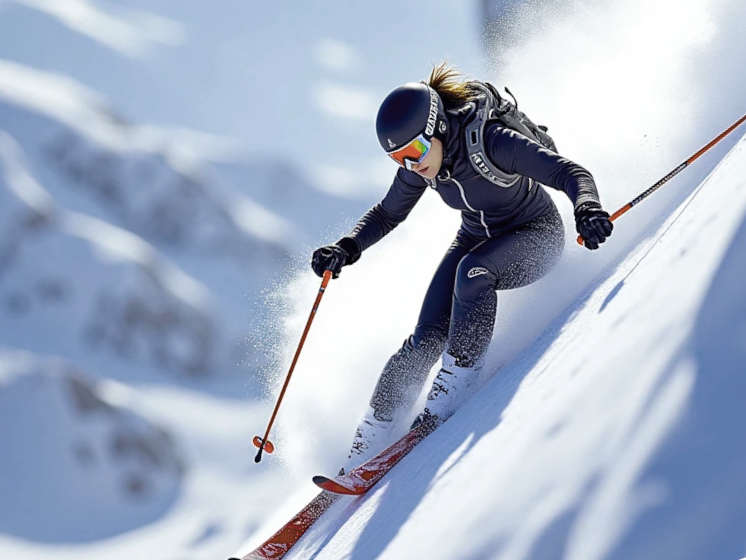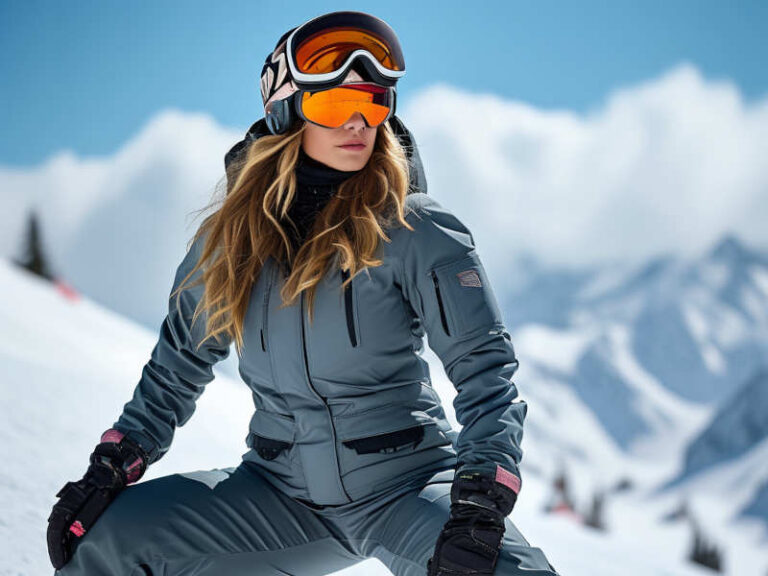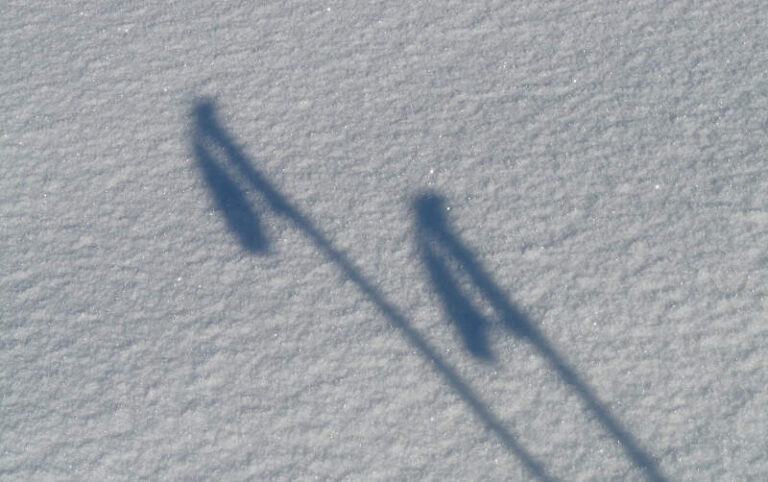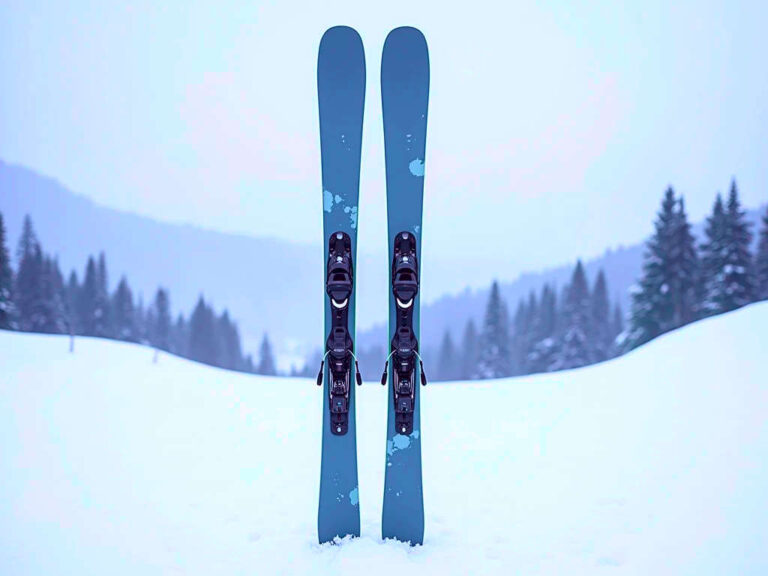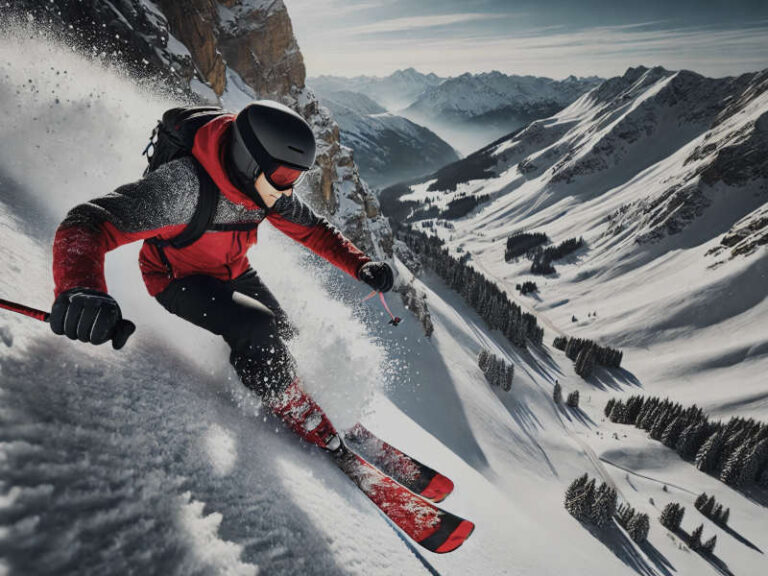How to Choose the Right Ski Pole for You
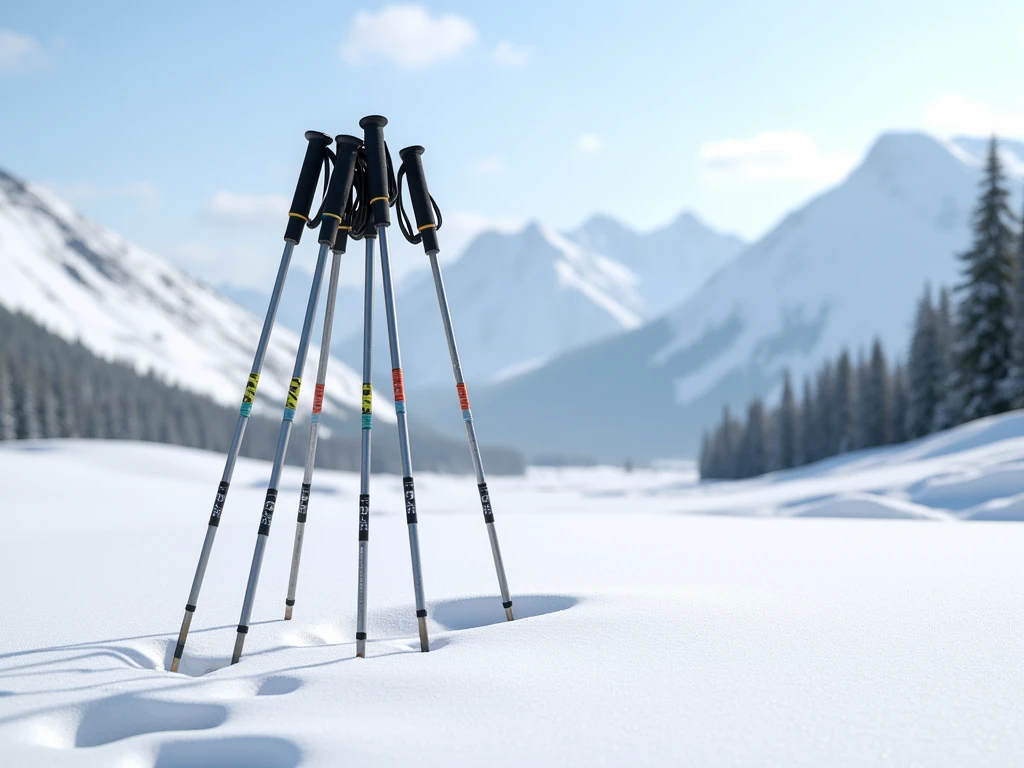
Let’s break down each part of a ski pole so you’ll know exactly what you’re working with when you hit the slopes. Ski poles are surprisingly simple, but each piece serves a purpose that’ll make a difference as you get more confident in your skiing.
Key Features of Ski Poles: What to Look For
1. Grip
- What it does: The grip is the part where you, well, grip the pole. It keeps your hands comfy and provides that key connection to the pole. Without a good grip, you’d be flinging your pole off into the powder every time you tried to plant it.
- Types available:
- Plastic Grips: Classic and tough, plastic grips are reliable and work well in most conditions. They’re not the coziest, but hey, if your hands are toasty in your gloves, you might not even notice.
- Rubber Grips: A bit softer and more comfortable than plastic, rubber grips are like an easygoing friend who’s just nice to have around. Less slippage, more cushion, better shock absorption.
- Foam Grips: For those who enjoy a warm, squishy feel! Foam grips add extra warmth and insulation so your hands don’t freeze onto the pole (exaggeration, but you get the idea). Great for comfort however wear down more quickly over time than other types. If comfort is your goal, foam grips have got your covered.
- Ergonomic Grips: These grips are molded to fit your hand like a glove. Great if you’re doing a lot of skiing, as they reduce hand fatigue and make holding the pole feel super natural.
- Shape: Look for a grip that fits comfortably in your hand, typically with a slight curve or groove for your fingers. This design provides more control and comfort.
- Size: Ensure that the grip size fits your hand. A larger hand may need a wider grip, while smaller hands benefit from slimmer grips for better control.
Quick Tip: Avoid the “death grip” on your poles. Many beginners hold on way too tight, which just makes your hands tired. Relax, let the grip do the work!
2. Strap
- What it does: The strap goes around your wrist and keeps the pole close by, even if you let go.
- Types available:
- Standard Adjustable Straps: These are the workhorses of the strap world—simple, secure, and adjustable so they can fit any size wrist.
- Padded Straps: Padded straps are for skiers who value comfort and want to avoid chafing. Picture long ski days where your poles feel like an extension of your arm—yep, that’s the magic of padding.
- Quick-Release Straps: These are the “smart” straps, made to release easily if you take a tumble. This little feature can help prevent wrist injuries when things go south.
Fun Fact: Ever seen someone forget to put their straps on and end up playing “catch the pole” down the slope? Always strap in for safety…and style!
3. Shaft
- What it does: The shaft is the long part that connects your hand to the snow. It’s lightweight yet strong—think of it as the backbone of the ski pole. The material and flexibility of the shaft affect how your pole feels and responds.
- Types available:
- Aluminum Shafts: Aluminum shafts are like the reliable old friend who’s always there when you need them. They’re durable, affordable, and take a beating. Beginners, this might be your go-to.
- Carbon Fiber Shafts: Sleek, light, and a bit on the fancy side, carbon fiber shafts are ideal for reducing fatigue. But they can be a little “bendier,” and be aware they’re not as rugged as aluminum.
- Composite Shafts: A nice mix of materials (like fiberglass and carbon), composite shafts balance durability and flexibility. Think of them as the happy medium for those who want performance but don’t need top-tier pro gear.
- Bamboo Shafts: An environmentally friendly choice for those concerned about being nice to mother nature while on the slopes.
- Lightweight Poles: Lightweight poles made from carbon fiber or composite materials are easier to carry and maneuver, reducing arm fatigue. Beneficial for skiers focused on speed or distance.
- Heavier Poles: Heavier poles may be more durable and stable, often chosen by skiers who prioritize stability over speed, especially in rougher terrain.
Heads Up: Aluminum poles can bend, but carbon poles tend to snap if they break.
4. Basket
- What it does: The basket keeps your pole from sinking too deep into the snow, acting like a snowshoe for your pole. It’s essential for balance and control, especially in soft snow.
- Types available:
- Small Baskets: Perfect for groomed runs where you’re on hard snow, small baskets don’t add much drag and make for easy maneuvering.
- Large Baskets: Designed for powder days! With these, you won’t be constantly digging your poles out of waist-deep snow. (Trust me, no one wants to see you wrestling with a pole stuck three feet under!)
- Interchangeable Baskets: These are great for skiers who like variety. You can switch out the baskets depending on whether you’re in deep powder or sticking to packed trails.
Pro Tip: If you find yourself pole-deep in snow every few meters, you might be rocking the wrong basket size. Bigger baskets for deep powder, smaller ones for packed trails. Read more about how to choose and replace ski baskets.
5. Tip
- What it does: The tip digs into the snow and gives you traction. Without a sharp tip, the pole would just skid around like a lost pencil. You’ll need it for stability, control, and steering.
- Types available:
- Steel Tips: The workhorse of ski pole tips. Steel is sharp, durable, and does the job on everything from hardpack to icy patches.
- Carbide Tips: For those who like it rugged, carbide is the next level up from steel. Tough as nails and great for rocky terrain, these tips are popular for backcountry poles.
- Plastic or Rubber Covers: Found on some beginner poles, these softer tips work fine for those just starting out and not skiing too aggressively.
Fun Thought: Carbide tips on ski poles are kind of like having the tires of a monster truck. You probably won’t use them to their full potential on smooth, groomed runs—but they’re ready if you hit any tough stuff!
Each piece of a ski pole may seem small, but together, they can make or break your experience on the slopes. Start with the basics and upgrade as you go! Who knows? A few seasons in, you may find yourself choosing between carbon shafts and ergonomic grips like a pro.
Are Ski Poles Necessary?
Ski poles are essential for most types of skiing. They improve balance, help maintain rhythm, and assist in turning. For advanced skiers, poles are necessary for handling different terrains and speeds. However, they may not be as crucial for first-time skiers or certain skiing styles, like freestyle skiing, where poles can sometimes be optional. For most other skiing styles, ski poles are highly recommended. Dig in deeper in our article with answers to common ski pole FAQs.
Choosing the Right Pole for Your Skiing Style
The type of skiing you plan to do affects what pole is best suited for you. Here’s a quick guide to help you decide:
- Alpine Skiing: Choose lightweight poles with strong durability. Medium-sized baskets work best for general use on groomed trails.
- Cross-Country Skiing: Opt for lightweight, longer poles for balance and rhythm over flat terrain.
- Freestyle Skiing: Poles aren’t always necessary, but if you choose to use them, go for shorter, lightweight poles with small grips and baskets.
- Backcountry Skiing: For powder and varied terrain, pick poles with adjustable lengths and larger baskets for better performance in deep snow.
Measuring Ski Poles: How to Find the Right Length
Ski poles are measured by length, typically in centimeters. The correct length depends on your height and skiing style.
For downhill skiing:
- Stand upright with your arms at your sides.
- Flip the ski pole upside down and grip it just beneath the basket.
- Your arm should form a 90-degree angle at the elbow when holding the pole.
Alternatively, you can use this quick reference guide based on your height:
| Skier Height | Recommended Pole Length (inches) | Recommended Pole Length (centimeters) |
|---|---|---|
| 4’6” – 4’8” | 39″ | 100 cm |
| 4’9” – 5’0” | 41″ | 105 cm |
| 5’1” – 5’3” | 43″ | 110 cm |
| 5’4” – 5’6” | 45″ | 115 cm |
| 5’7” – 5’9” | 47″ | 120 cm |
| 5’10” – 6’0” | 49″ | 125 cm |
| 6’1” – 6’3” | 51″ | 130 cm |
| 6’4”+ | 53″ | 135 cm |
For children, shorter poles may be required, and a simpler rule of thumb is to size down approximately 2 – 4 inches (5-10 cm) based on comfort and control.
What Are Ski Poles Made Of? Pros and Cons of Different Materials
Different materials provide unique benefits, which we touched on above. To help you further decide, here are pros and cons of each, as well as some examples:
Aluminum
- Pros: Durable, affordable, and resistant to damage from impacts.
- Cons: Heavier than other materials, which can lead to more fatigue.
- Best Use: Great for beginners or recreational skiers on groomed trails.
A budget-friendly 2024 aluminum ski pole option is the K2 Power Aluminum Ski Pole. This mid-range pole is lightweight, durable, and designed for skiers of all skill levels, making it ideal if you’re after solid performance without stretching your budget. It has a reliable all-mountain grip, allowing for a comfortable, secure hold on various terrains, from groomed runs to deeper snow. Plus, it comes with a standard basket suited for most alpine conditions, keeping things straightforward for beginner to intermediate skiers.
Carbon Fiber
- Pros: Extremely lightweight, reducing fatigue, with excellent shock absorption.
- Cons: More expensive and can be less durable if hit by force.
- Best Use: Ideal for advanced skiers who prioritize speed and precision.
A popular carbon fiber ski pole for 2024 that fits the mid-range price point is the Armada Carbon Adjustable Ski Pole. This model is designed with backcountry and freeride skiers in mind, offering both a lightweight feel and an adjustable length feature that’s helpful for diverse terrain. This flexibility makes it easy to adapt to various slopes or stow the poles more compactly. The pole’s carbon fiber construction keeps it very light, which is ideal for long days on the mountain, reducing fatigue from repetitive arm movements.
Another option, though at a slightly higher price point, is the Salomon MTN Carbon S3. This pole combines lightweight carbon with Kevlar reinforcement for added durability, making it suitable for both backcountry adventures and more technical descents. It features an ergonomic grip and a detachable strap system for safety, making it one of the top-rated options for weight-conscious skiers who need both performance and resilience
Composite
- Pros: Blends durability and lightweight qualities, with decent shock absorption.
- Cons: Can still be more expensive than aluminum, though more affordable than carbon fiber.
- Best Use: A good balance for intermediate to advanced skiers who want quality without the high price tag of carbon fiber.
For a popular composite ski pole in 2024, the Komperdell D’Scent Vario has received high marks and positive feedback. This pole combines a lightweight carbon lower shaft with an aluminum upper, making it ideal for skiers looking for a balance of strength and lightness in both resort and backcountry environments. It’s adjustable (from 110 to 140 cm), allowing flexibility depending on the terrain and snow conditions, and features a convenient removable strap. The pole’s baskets also pivot up to 28 degrees, which enhances grip during uphill climbs—an advantage for those venturing off-piste.
Another well-rated option is the Black Crows Duos Freebird. Known for its minimalist design, this pole is favored for its durability, extended grip, and ease of use on steep terrain. The upper shaft’s narrower diameter allows it to plunge effectively into snow, providing added stability for challenging climbs.
Bamboo
- Pros: Eco-friendly, durable, and aesthetically appealing.
- Cons: Heavier than synthetic materials and may require more maintenance.
- Best Use: A unique choice for environmentally conscious skiers looking for a durable and natural feel.
A highly-rated bamboo ski pole to consider for 2024 is the Booyah Bamboo Ski Poles. These eco-friendly poles are well-loved for their durability and balance of strength and flexibility. Made in Colorado, they use bamboo sourced for its impressive strength-to-weight ratio, which rivals materials like aluminum and carbon fiber. The poles come with customizable grip colors and can be personalized with or without pole straps, adding a unique touch. Not only are these poles strong and lightweight, but they also boast eco-friendly benefits as bamboo is a renewable resource that absorbs significant carbon dioxide during growth
Another noteworthy option is Rimfors Bamboo Poles from Sweden, praised for their lightweight feel and balance, which some users find on par with carbon and aluminum poles. The design emphasizes flexibility while providing enough rigidity for reliable downhill use, and they are custom-made to the exact length needed
How Should Ski Poles Fit
Different skiing styles might call for slightly different lengths. For instance, skiers who prioritize speed and turning (like racers) might use poles that are a bit shorter for increased maneuverability, while taller poles are sometimes chosen by those venturing off-piste or in powder for extra support.
Final Tips on Ski Pole Selection
- Match Pole Type to Skiing Style: Know your skiing style and match it with the best pole material, length, and grip.
- Comfort and Control Are Key: Grips, straps, and the pole’s weight all contribute to comfort. Test different types if possible to find what feels right.
- Invest Wisely: While it can be tempting to go for the most expensive materials, pick poles that suit your current skill level and skiing goals.
Click here to see our choices for the best ski poles.

by: Cory Willins
Cory is a dynamic and passionate content writer, specializing in sports-related topics. With over a decade of experience in the field, Cory has established… read more

